 |
Apollo astronauts orbiting the moon view the rising of the beautiful planet earth from a quarter of a million miles away, Christmas Eve, 1968. [Photo, courtesy National Aeronautics and Space Administration (NASA)] |
“ By a lucky coincidence, the Canadian government picked this time [1959] to cancel the Avro CF 105 Arrow, a supersonic interceptor, and Gilruth [head of NASA Space Task Group] acquired 25 experienced Canadian engineers.”
It is generally well known that the ingenious CANADARM manipulating device carried on all NASA Shuttle vehicles to launch and repair satellites and other spacecraft was designed and built in Canada by Spar Aerospace. The virtually faultless operation of the arm has been a major influence in the successful launch of a large number of important projects over fifteen years of Shuttle operations. However, less well known is Canada’s tremendous contribution to the United States space programs in the pioneering days of the late ’50s and throughout the ’60s and early ’70s when the single-man Mercury, the two-man Gemini, and the moon-landing Apollo projects were being developed.From Lift-off (1988) by Michael Collins, Command Module pilot,
Apollo 11 moon landing
 |
Apollo astronauts orbiting the moon view the rising of the beautiful planet earth from a quarter of a million miles away, Christmas Eve, 1968. [Photo, courtesy National Aeronautics and Space Administration (NASA)] |
The cancellation of the Avro Arrow supersonic fighter project on February 20, 1959, initiated the breakup of the extraordinarily talented team of engineers at Avro Canada, a team that had put Canada at the forefront of world aviation technology with the design and development of such projects as the C 102 Jetliner, the first jet passenger plane to fly in North America, the CF 100 all-weather fighter, and the legendary CF 105 Arrow.
In the meantime, the newly formed Space Task Group at the National Aeronautics and Space Administration (NASA) facility at Langley, Virginia, led by Robert Gilruth, former Assistant Director of the National Advisory Committee for Aeronautics, was overloaded with urgent work on the Mercury space capsule design. At the time Gilruth was desperate to find experienced engineering personnel to develop the project. Gilruth had been involved in the wind tunnel and free-flight model testing of the Arrow models at Langley and the firing range on Wallops Island and was well aware of the unique capabilities of the Avro engineering team. He was quick to take advantage of their availability and made an arrangement with Avro to borrow a team of approximately 25 engineers to go to Langley and work on the development of Mercury.
The idea was to keep
the ex-Avro engineers together as a team, with the intention of returning
them when Avro sorted out the future of the company in the light of the
Arrow cancellation. On the later demise of Avro Canada, the loan
became permanent and the Canadian engineers were integrated into the Space
Task Group, later contributing to both the Gemini and Apollo
projects.
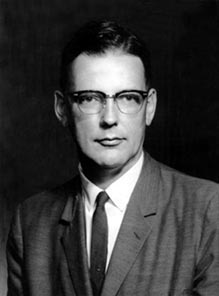 |
A graduate of the University of Toronto and a brilliant aerodynamicist at Avro Canada where he had been Chief of Design, Jim Chamberlin left Canada for the U.S. shortly after the cancellation of the Avro Arrow. Leading a team of some 25 gifted engineers to assist NASA in the development of the Mercury project, Chamberlin’s departure initiated Canada’s “brain drain.” [Photo, courtesy Estate of James Chamberlin] |
At the time of the Arrow cancellation, the Canadian team was led by the Chief of Design at Avro, Jim Chamberlin. His career provides an example of the type of Canadian expertise made available to NASA at that time. Chamberlin was born in Kamloops, British Columbia, in 1915. He and his mother came to Toronto after his father was killed in World War I. He attended the University of Toronto Schools at Bloor and Spadina and is remembered by his colleagues and family for being, in his younger days, obsessed with model airplanes which he designed and flew in rapid succession.
He later graduated from the University of Toronto and also obtained a diploma from Imperial College in England. In the early 1940s he went as an aerodynamicist to work for Robert Noorduyn in Montreal. When A.V. Roe Canada (the parent company of Avro Canada) was established in 1945, he joined the engineering team as an aerodynamicist, later becoming head of the small initial project office and one of the senior designers at Avro. His work on the C 102 Jetliner, the first jet transport to fly in North America, the CF 100 fighter, and the supersonic Arrow was largely responsible for the remarkable flying characteristics of those aircraft.
On his appointment
as team leader of the Canadians at the Space Task Group at Langley, Virginia,
Chamberlin became Gilruth’s close advisor and played a major role in the
final design of the Mercury
capsule that put John Glenn into orbit
on February 20th, 1962 – ironically just three years to the day after the
abortive cancellation of Canada’s
Arrow
project. He became head
of engineering and administration on the Mercury
project and later
head of the U.S. Space Task Group’s engineering division, directing the
multimillion dollar two-man Gemini
project and becoming deeply involved
in the project Apollo moon lander. Chamberlin received the NASA
Gold Medal for his work on Gemini and was described by one of the NASA
administrators as “one of the most brilliant men ever to work with NASA.”
At the time of his death in 1981 he was Technical Director for McDonnell
at the Johnson Space Centre in Houston.
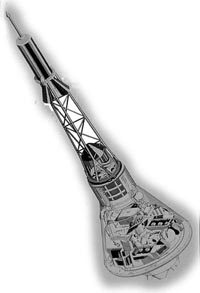  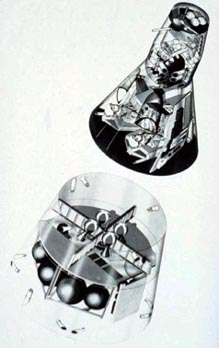 |
| 1. Canadian Jim Chamberlin played a major role in the final design of Mercury. This sketch of the Mercury spacecraft is the exact rendition of the one in which John Glenn orbited the earth on February 20, 1962 – just three years to the day after the Avro Arrow cancellation. [Photo, courtesy NASA via William Mellberg] 2. Jim Chamberlin received the NASA Gold Medal for his work on Gemini. Viewed here, astronauts Wally Schirra and Tom Stafford in Gemini 6 photograph Gemini 7 with Frank Borman and Jim Lovell aboard during the first space rendezvous on December 15, 1965. [Photo, courtesy NASA via William Mellberg] 3. As head of the U.S. Space Task Group’s engineering division, Jim Chamberlin, born in Kamloops, British Columbia, directed the multimillion dollar two-man Gemini project. Viewed left, the Gemini spacecraft was much more than an enlarged Mercury. Though the two-man crew was still crowded inside a small cabin, much of their equipment was located in a two-part Adapter Module attached to the rear of the Re-Entry Module. Four solid rocket motors were housed in the Retrograde Section, while oxygen, propellants (for the thrusters) and fuel cells (for electricity) were housed in the Equipment Section. The astronauts sat side-by-side, each man having his own hatch and a forward-looking window. [Caption and photo, courtesy NASA via William Mellberg] |
While Chamberlin’s monumental impact on the United States space programs has to some extent been recognized in writings about that period, little has been written about the contributions made by the other members of the Canadian contingent who went with him to Langley. All of them contributed to the success of the American space programs, many becoming leaders of the NASA working groups involved in the design, development, launching, and tracking of the Mercury, Gemini, and Apollo vehicles. John Hodge became flight director on the Mercury, Gemini and Apollo spacecraft. Fred Matthews was a back-up flight director to the legendary Chris Kraft and was in charge of flight monitoring and the flight controllers at the tracking stations around the world. Tec Roberts was in charge of the trajectory group in mission control and in 1962 was largely responsible for the design of the Mission Control Center at NASA’s Lyndon B. Johnson Space Centre in Houston, Texas. Owen Maynard, who became chief of the Systems Engineering Division on the Apollo spacecraft, was recognized as the focal point on that program and played a major role in the development of the Lunar Module Eagle, which placed Neil Armstrong and Buzz Aldrin on the moon in July 1969 – and the list goes on and on! Perhaps the most succinct categorization of their contributions is contained in Apollo, the Race to the Moon (1969) by authors Charles Murray and Catherine Bly-Cox:
As the Space Task Group’s burden was threatening to overwhelm it, the Canadian government unintentionally gave the American space program its luckiest break since Wernher von Braun had surrendered to the Americans.... The Canadians ... never gained much public recognition for their contribution to the manned space program, but to the people within the program, their contribution was incalculable.
One of the original American members of the Space Task Group recalled:
They had it all over us in some areas ... just brilliant guys ... they were more mature and were bright as hell and talented and professional to a man.
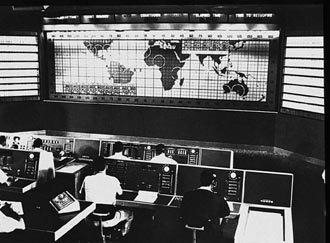 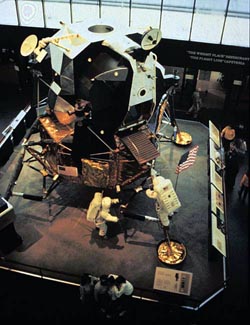 |
| 1. Mission control for Mercury flights at Cape Canaveral, Florida. Ex-Avro engineer John Hodge was flight director on Mercury. The flight director of any space mission was described by astronaut Mike Collins as “the high priest.” [Photo, courtesy NASA via Fred Matthews] 2. Canadian Owen Maynard played a major role in the development of the Lunar module Eagle. On July 20, 1969, Apollo 11 astronauts Neil Armstrong and Edwin (“Buzz”) Aldrin touched down on the moon in the Lunar Module Eagle. The first lunar landing is recreated, right, with a spare LM at the Smithsonian’s National Air & Space Museum in Washington, D.C. [Photo, courtesy William Mellberg] |
Some of the exploits of the “famous twenty-five” have also been captured in other documents, but little has ever been revealed about the contributions to the American space programs made by other ex-Avro Canada engineers. Robert Lindley, chief engineer at Avro at the time of the Arrow cancellation, went to McDonnell Aviation in St. Louis and was in charge of their work on the Gemini spacecraft for NASA. He later joined NASA on the Shuttle program, becoming director of engineering and operations for manned space flight. In 1972 he was appointed director of project management at the Goddard Space Flight Centre. Mario Pesando, chief of project research at Avro, went to RCA headquarters in Massachusetts to work on the Saturn V project to launch the astronauts to the moon. Carl Lindow, formerly project manager on the Arrow project, went to Boeing and became project engineer on their Saturn S-1 and Saturn S-IB rocket proposals. The list of contributions to the American space activity made by the great team of Canadian engineers from Avro could fill a book. It is to be hoped that some time in the future the entire story of this remarkable episode in the development of space technology will become better known.
On a wintry day in
February 1962, as four million Americans watched with pride as a cavalcade
of limousines slowly made their way along the streets of New York to wild
cheers and mountains of ticker tape, America’s first astronaut to orbit
the earth, John Glenn, waved in appreciation to the crowds from the first
car. In the second car was a quiet Canadian from Kamloops – James A. Chamberlin
– Oh Canada!!
 |
Launch of the first manned Apollo spacecraft on October 11, 1968. Chamberlin, Maynard, and other Canadian engineers were deeply involved in the Apollo spacecraft programs. [Photo, courtesy NASA via William Mellberg] |
After the successful Gemini program in the late 1960s, a grateful American nation presented Jim Chamberlin with a certificate which was not only unprecedented, but which said it all:
National Aeronautics and Space Administration (NASA) Manned Spacecraft Centre presents this certificate of commendation to James A. Chamberlin for his outstanding contribution to this nation’s space flight programs, for the technical direction and leadership of the Project Mercury, for his creation and promotion of the Gemini concept and for his guidance in the design of all manned spacecraft used in the United States’ exploration of space to date.
Jim FloydSigned – Robert R. Gilruth, Director, Manned Spacecraft Centre, Houston, Texas.